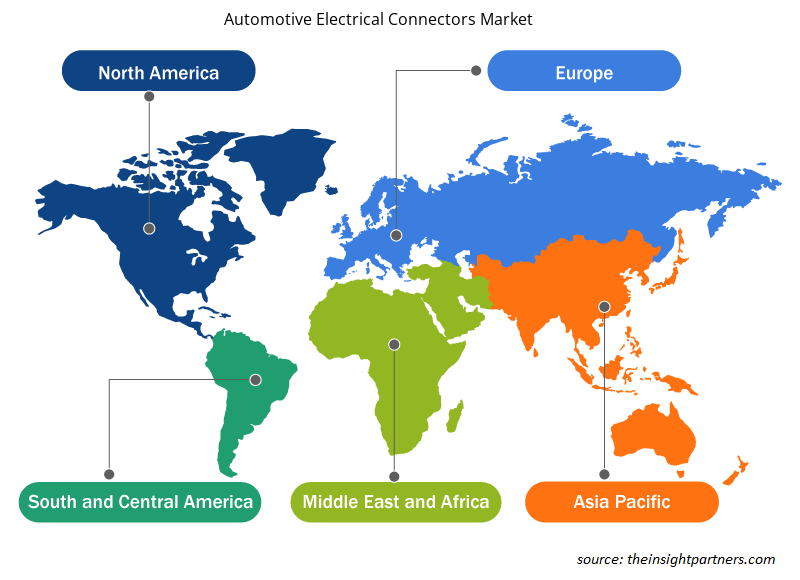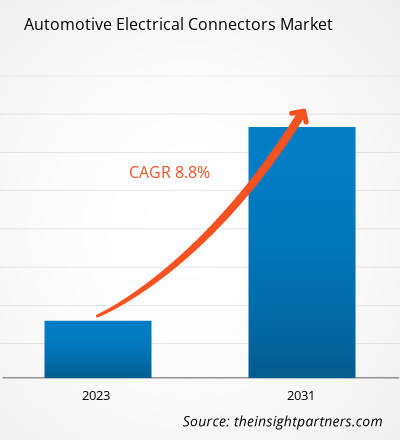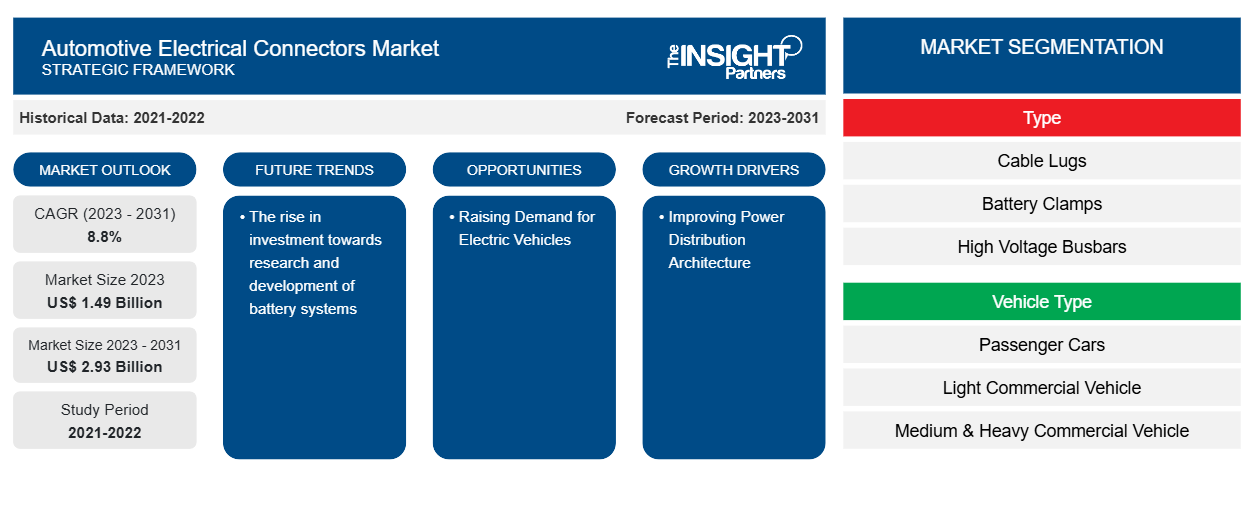Si prevede che la dimensione del mercato dei connettori elettrici per autoveicoli raggiungerà i 2,93 miliardi di dollari entro il 2031, rispetto agli 1,49 miliardi di dollari del 2023. Si prevede che il mercato crescerà a un CAGR dell'8,8% nel periodo 2023-2031. L'aumento degli investimenti nella ricerca e nello sviluppo di sistemi di batterie rimarrà probabilmente una tendenza chiave nel mercato.
Analisi di mercato dei connettori elettrici per autoveicoli
Si prevede che un aumento dell'elettrificazione delle infrastrutture di trasporto e dei veicoli in tutto il mondo stimolerà la domanda di connettori elettrici per autoveicoli, che a sua volta dovrebbe alimentare la crescita del mercato nei prossimi anni. Inoltre, si prevede che il miglioramento dell'architettura di distribuzione dell'energia elettrica stimolerà la crescita del mercato dei connettori elettrici per autoveicoli durante il periodo di previsione. Inoltre, si prevede che l'aumento della domanda di veicoli elettrici e veicoli elettrici ibridi creerà opportunità per le principali aziende che operano nel mercato dal 2023 al 2031.
Panoramica del mercato dei connettori elettrici per autoveicoli
L'ecosistema del mercato dei connettori elettrici per autoveicoli comprende i seguenti stakeholder: fornitori di materie prime, produttori di connettori, OEM e utenti finali. I fornitori di materie prime forniscono il materiale per costruire i connettori elettrici per autoveicoli, come rame, nichel e argento. Inoltre, i piccoli componenti vanno da una piccola vite a una scatola di chiusura. I produttori di connettori eseguono vari processi, come progettazione, assemblaggio e produzione, per trasformare le materie prime in prodotti finiti. INTERCABLE srl, Amphenol Corporation e Rogers Corporation, tra gli altri, sono i principali produttori di connettori elettrici per autoveicoli.
Le aziende offrono vari tipi di prodotti, come capicorda, barre di distribuzione ad alta tensione, morsetti per batterie e scatole portafusibili ai produttori di veicoli e ai clienti aftermarket. Questi connettori elettrici vengono acquistati da OEM come Volkswagen, Toyota, Volvo, Daimler e Ford Motor Company. Gli utenti finali hanno un gran numero di clienti, dagli acquirenti di veicoli per uso personale agli operatori di flotte. Le aziende produttrici di connettori elettrici per autoveicoli forniscono anche un servizio post-vendita ai clienti per la sostituzione dei connettori dei veicoli.
Personalizza questo report in base alle tue esigenze
Riceverai la personalizzazione gratuita di qualsiasi report, comprese parti di questo report, o analisi a livello nazionale, pacchetto dati Excel, oltre a usufruire di grandi offerte e sconti per start-up e università
-
Scopri le principali tendenze di mercato in questo rapporto.Questo campione GRATUITO includerà analisi di dati che spaziano dalle tendenze di mercato alle stime e alle previsioni.
Driver e opportunità di mercato per i connettori elettrici per autoveicoli
Migliorare l'architettura della distribuzione di energia per favorire il mercato
Le nazioni sviluppate come gli Stati Uniti, il Regno Unito e la Germania si stanno spostando con decisione verso l'uso di veicoli elettrici. Le aziende che operano nella regione sviluppata stanno sviluppando tecnologie di batterie ad alta tensione per migliorare la potenza dei veicoli e la capacità di accumulo di energia. Pertanto, la domanda di connettori di supporto per fornire connessioni di potenza efficienti sta crescendo, rafforzando così la crescita del mercato. Nuovi prodotti elettrici come scatole portafusibili, capicorda e barre collettrici sono in fase di sviluppo per migliorare la distribuzione di energia. Le scatole portafusibili sono necessarie per mantenere una distribuzione di energia efficiente, il che sta aumentando la domanda di scatole portafusibili, guidando così il mercato.
Ad esempio, nell'aprile 2021, Eaton, il segmento aziendale eMobility, si è aggiudicato un contratto per sviluppare fusibili della serie Bussmann e unità di distribuzione dell'alimentazione (PDU) per i produttori di veicoli. Le PDU, note anche come scatole portafusibili, saranno utilizzate per un nuovo veicolo elettrico a batteria (BEV) per applicazioni commerciali leggere. Le scatole portafusibili trasmettono l'alimentazione della batteria ai componenti del veicolo con una funzione di sicurezza fornendo protezione del circuito. La mutevole architettura di distribuzione dell'alimentazione sta creando la domanda di nuove scatole portafusibili, stimolando così la crescita del mercato.
Aumento della domanda di veicoli elettrici
I governi di diversi paesi emanano normative specifiche per controllare le emissioni dei veicoli diesel e benzina. Pertanto, a causa di questo standard, i produttori di veicoli stanno spostando la loro attenzione verso la produzione di veicoli ibridi plug-in, veicoli ibridi e veicoli elettrici a batteria. Le emissioni dei veicoli sono la principale fonte di inquinamento a livello mondiale e veicoli come auto, camion e autobus sono i maggiori contributori in questa categoria. L'elevata efficienza dei veicoli elettrici (EV) rispetto ai tradizionali veicoli diesel e a gas naturale è tra i fattori chiave che si prevede alimenteranno il mercato dei connettori elettrici per autoveicoli durante il periodo di tempo analizzato. Inoltre, i governi di vari paesi come Stati Uniti, Regno Unito e Germania offrono programmi di sovvenzione per promuovere l'utilizzo di veicoli elettrici. Pertanto, si prevede che l'aumento della domanda di veicoli elettrici creerà opportunità per le aziende chiave nel mercato dei connettori elettrici per autoveicoli dal 2023 al 2031.
Analisi della segmentazione del rapporto di mercato dei connettori elettrici per autoveicoli
I segmenti chiave che hanno contribuito alla derivazione dell'analisi del mercato dei connettori elettrici per autoveicoli sono il tipo, il tipo di veicolo e il tipo di gruppo propulsore
- In base al tipo, il mercato dei connettori elettrici per autoveicoli è suddiviso in capicorda, morsetti per batteria, barre di distribuzione ad alta tensione e scatole portafusibili. Il segmento delle scatole portafusibili ha detenuto la quota di mercato maggiore nel 2023.
- Per tipo di veicolo, il mercato è segmentato in autovetture, veicoli commerciali leggeri (LCV) e veicoli commerciali medi e pesanti (M&HCV). Il segmento delle autovetture ha detenuto la quota maggiore del mercato nel 2023.
- In base al tipo di propulsore, il mercato è diviso in motore a combustione interna (ICE), veicolo elettrico (EV), veicolo elettrico ibrido plug-in (PHEV) e veicolo elettrico ibrido (HEV). Il segmento dei motori a combustione interna ha detenuto una quota significativa del mercato nel 2023.
Analisi della quota di mercato dei connettori elettrici per autoveicoli per area geografica
L'ambito geografico del rapporto sul mercato dei connettori elettrici per autoveicoli è suddiviso principalmente in cinque regioni: Nord America, Asia Pacifico, Europa, Medio Oriente e Africa, Sud e Centro America.
L'ambito del rapporto sul mercato dei connettori elettrici per autoveicoli comprende Nord America (Stati Uniti, Canada e Messico), Europa (Spagna, Regno Unito, Germania, Francia, Italia e resto d'Europa), Asia Pacifico (Corea del Sud, Cina, India, Giappone, Australia e resto dell'Asia Pacifico), Medio Oriente e Africa (Sudafrica, Arabia Saudita, Emirati Arabi Uniti e resto del Medio Oriente e dell'Africa) e Sud America (Brasile, Argentina e resto del Sud America). In termini di fatturato, l'Asia Pacifico ha dominato la quota di mercato dei connettori elettrici per autoveicoli nel 2023. L'Europa è il secondo maggiore contributore al mercato globale dei connettori elettrici per autoveicoli, seguita dal Nord America.
Approfondimenti regionali sul mercato dei connettori elettrici per autoveicoli
Le tendenze regionali e i fattori che influenzano il mercato dei connettori elettrici per autoveicoli durante il periodo di previsione sono stati ampiamente spiegati dagli analisti di Insight Partners. Questa sezione discute anche i segmenti e la geografia del mercato dei connettori elettrici per autoveicoli in Nord America, Europa, Asia Pacifico, Medio Oriente e Africa e Sud e Centro America.

- Ottieni i dati specifici regionali per il mercato dei connettori elettrici per autoveicoli
Ambito del rapporto di mercato sui connettori elettrici per autoveicoli
| Attributo del report | Dettagli |
|---|---|
| Dimensioni del mercato nel 2023 | 1,49 miliardi di dollari USA |
| Dimensioni del mercato entro il 2031 | 2,93 miliardi di dollari USA |
| CAGR globale (2023-2031) | 8,8% |
| Dati storici | 2021-2022 |
| Periodo di previsione | 2023-2031 |
| Segmenti coperti |
Per tipo
|
| Regioni e Paesi coperti |
America del Nord
|
| Leader di mercato e profili aziendali chiave |
|
Densità degli attori del mercato dei connettori elettrici per autoveicoli: comprendere il suo impatto sulle dinamiche aziendali
Il mercato dei connettori elettrici per autoveicoli sta crescendo rapidamente, spinto dalla crescente domanda degli utenti finali dovuta a fattori quali l'evoluzione delle preferenze dei consumatori, i progressi tecnologici e una maggiore consapevolezza dei vantaggi del prodotto. Con l'aumento della domanda, le aziende stanno ampliando le loro offerte, innovando per soddisfare le esigenze dei consumatori e capitalizzando sulle tendenze emergenti, il che alimenta ulteriormente la crescita del mercato.
La densità degli operatori di mercato si riferisce alla distribuzione di aziende o società che operano in un particolare mercato o settore. Indica quanti concorrenti (operatori di mercato) sono presenti in un dato spazio di mercato in relazione alle sue dimensioni o al valore di mercato totale.
Le principali aziende che operano nel mercato dei connettori elettrici per autoveicoli sono:
- INTERCABLE Srl
- Produzione Connor
- Società per azioni Amphenol
- Azienda Emerson Electric
- Società Rogers
- Molex
Disclaimer : le aziende elencate sopra non sono classificate secondo un ordine particolare.

- Ottieni una panoramica dei principali attori del mercato dei connettori elettrici per autoveicoli
Notizie di mercato e sviluppi recenti sui connettori elettrici per autoveicoli
Il mercato dei connettori elettrici per autoveicoli viene valutato raccogliendo dati qualitativi e quantitativi dopo la ricerca primaria e secondaria, che include importanti pubblicazioni aziendali, dati di associazioni e database. Di seguito sono elencati alcuni degli sviluppi nel mercato dei connettori elettrici per autoveicoli:
- ENNOVI (società di elettrificazione della mobilità) ha introdotto la soluzione di connettore ethernet per autoveicoli ENNOVI-Net con interconnessioni press-fit. Questo lancio di prodotto ha migliorato il portafoglio prodotti dell'azienda in questo mercato. (Fonte: ENNOVI, comunicato stampa, marzo 2024)
- ETCO ha introdotto connettori per veicoli elettrici. Questo nuovo connettore può resistere a forti vibrazioni, urti e temperature estreme. Questi connettori sono utilizzati tra i pacchi batteria e i sistemi di gestione della batteria. (Fonte: ETCO, comunicato stampa, maggio 2022)
Copertura e risultati del rapporto sul mercato dei connettori elettrici per autoveicoli
Il rapporto "Dimensioni e previsioni del mercato dei connettori elettrici per autoveicoli (2021-2031)" fornisce un'analisi dettagliata del mercato che copre le seguenti aree:
- Dimensioni e previsioni del mercato dei connettori elettrici per autoveicoli a livello globale, regionale e nazionale per tutti i principali segmenti di mercato coperti dall'ambito
- Tendenze del mercato dei connettori elettrici per autoveicoli e dinamiche di mercato come driver, sistemi di ritenuta e opportunità chiave
- Analisi PEST e SWOT dettagliate
- Analisi di mercato dei connettori elettrici per autoveicoli che copre le principali tendenze del mercato, il quadro globale e regionale, i principali attori, le normative e i recenti sviluppi del mercato
- Analisi del panorama industriale e della concorrenza che copre la concentrazione del mercato, l'analisi della mappa di calore, i principali attori e gli sviluppi recenti per il mercato dei connettori elettrici per autoveicoli
- Profili aziendali dettagliati
- Analisi storica (2 anni), anno base, previsione (7 anni) con CAGR
- Analisi PEST e SWOT
- Valore/volume delle dimensioni del mercato - Globale, Regionale, Nazionale
- Industria e panorama competitivo
- Set di dati Excel
Report recenti
Testimonianze
Motivo dell'acquisto
- Processo decisionale informato
- Comprensione delle dinamiche di mercato
- Analisi competitiva
- Analisi dei clienti
- Previsioni di mercato
- Mitigazione del rischio
- Pianificazione strategica
- Giustificazione degli investimenti
- Identificazione dei mercati emergenti
- Miglioramento delle strategie di marketing
- Aumento dell'efficienza operativa
- Allineamento alle tendenze normative























 Ottieni un campione gratuito per - Mercato dei connettori elettrici per autoveicoli
Ottieni un campione gratuito per - Mercato dei connettori elettrici per autoveicoli